Anatomy and Dermatoglyphics of Three Sasquatch Footprints
By Grover S. Krantz
Casts of three large human-like footprints were made by U.S. Forest Service personnel in June, 1982, in southeastern Washington State. The fine-grained soil preserved many impressions of dermal ridges and sweat pores. Careful study by dermatoglyphics experts shows these impressions are perfectly consistent with the friction skin found only in higher primates. The foot size of 37.5 x 17 cm rules out any known primate; the nonopposed first digit indicates a hominid. Physical circumstances suggest a body weight of 300 to 400 kg. It is believed that all possible methods of faking this evidence have been considered, and ruled out.
Introduction
New animal species become generally accepted when a physical specimen is collected and properly described. Most commonly, living species are initially demonstrated by the skin and skull of one individual. Extinct species are based on fossilized bone or shell, often on rather small framents. Some are proposed even on the basis of such indirect evidence as burrows or tracks. In all cases, something tangible is required, which is deposited in a collection somewhere, and which can be examined later by persons other than the discoverer. Only in the case of relatively unimportant subspecies might acceptance be based only on unsubstantiated observations by qualified authorities.There are no clear rules about the kind and amount of evidence that must be provided in each case. Instead, there is an unstated consensus that this evidence depends on the nature of the animal, or more properly, on our emotional reactions to it. The more unlikely or unexpected the species, the more proof is required to establish its existence. A new subspecies of chipmunk might be seriously considered on the eye-witness testimony of one competent zoologist. But if the giraffe were unknown to science, five expert accounts, supported by photographs and footprints, would hardly suffice. Similarly, the first platypus skin brought to Europe was suspected of being faked.
There have been persistent reports for over a century that a species of large bipedal, higher primate, known as Sasquatch or Bigfoot, lives wild in North America, and other areas as well. (This is not the place to present detailed information on these reports, but the interested reader might consult Green [1978], and Hunter and Dahinden [1973].) Quite rightly, zoologists and anthropologists have not accepted this animal on the testimony of claimed eyewitnesses, however many these may be. The supposed species is too unexpected, as well as potentially too significant, to base any firm conclusions on unverified accounts. If we accepted every creature that is supported by the testimony of ten or more claimed sightings, then we would have a truly unwieldy zoological inventory of mostly unclassifiable creatures, including unicorns, goblins, griffins, fairies, moth-men, and the like.
Most scientists would agree that only good skeletal evidence would establish the reality of a species like the Sasquatch (a North American Indian name). A few specialists would be satisfied with such esoteric evidence as a test-tube full of blood. Likewise, a few specialists would be convinced by anatomically clear footprints recorded under satisfactory circumstances. If we were simply dealing with an over-sized subspecies of an accepted animal, such footprints would probably gain general acceptance. As it is, however, we should not be surprised if the best-of all-possible foot impressions of a Sasquatch were ignored or denied by most of the scientific establishment. That is exactly what we are now confronted with.
Background
On June 10, 1982, U.S. Forest Service patrolman Paul Freeman was surveying elk in the Umatilla National Forest, on the border of Washington and Oregon states. That morning, he reported seeing at relatively close range an animal of human shape, hair covered, standing about 2.5 m tall, with an estimated weight of 400 kg. This event is typical of the hundreds of descriptions of encounters with the supposed but unverified Sasquatch. Other Forest Service personnel from the Walla Walla Ranger District Office in Walla Walla, Washington (where Freeman was employed), were called to the scene that day, and they observed many apparent footprints that were consistent with an animal of that description. Many photographs were taken, and a plaster cast was made of one of these impressions (Fig. 1, right). The following day, a search and rescue team on an unrelated mission came upon the scene, took more photographs, made another cast (Fig. 2), and, attempted to track the creature. One week later, on June 17, Freeman and, other foresters encountered more footprints a few miles away, at a place called Elk Wallow, this time of two individuals. One of these sets of tracks matched the tracks at the sighting location, and a third cast was made (Fig 1, left). The second individual left slightly different tracks, and three casts were made of these (Figs. 3 and 4). The analysis in this article centers on these three new tracks (made by the second individual) from Elk Wallow, in the Mill Creek Watershed. (For more background information, see ISC Newsletter [1982a])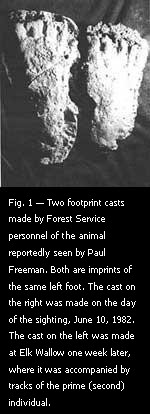 During the following winter, Freeman and other investigators found additional tracks on several occasions. They made more plaster casts indicating the existence of at least two more individuals. In all, 11 casts of four distinguishable types have been made. Five of these casts were made by Forest Service workers in June of 1982, and the originals are still in my possession, pending their ultimate disposition. One made by Art Snow of the search and rescue team, and five more made by Paul Freeman himself, have been copied with latex or Silastic molds and returned to their owners.
During the following winter, Freeman and other investigators found additional tracks on several occasions. They made more plaster casts indicating the existence of at least two more individuals. In all, 11 casts of four distinguishable types have been made. Five of these casts were made by Forest Service workers in June of 1982, and the originals are still in my possession, pending their ultimate disposition. One made by Art Snow of the search and rescue team, and five more made by Paul Freeman himself, have been copied with latex or Silastic molds and returned to their owners.
The prevailing soil type in this region is wind-blown loess, a very fine-grained substance with typical particle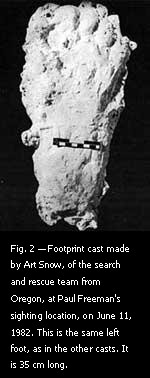 sizes of around 0.01 mm diameter. When this soil is damp and cool, and pressed into by a warm body, a detailed imprint commonly remains. Most, if not all, of these tracks were cast within a day of the time of impression, so they had not dried out, nor had they received any intrusive material. The well mixed casting plaster that was poured into these impressions was able to record any degree of detail that was held by the soil. Variations down to less than 0.1 mm are faithfully preserved. This is fine enough to show individual dermal ridges and their sweat pores.
sizes of around 0.01 mm diameter. When this soil is damp and cool, and pressed into by a warm body, a detailed imprint commonly remains. Most, if not all, of these tracks were cast within a day of the time of impression, so they had not dried out, nor had they received any intrusive material. The well mixed casting plaster that was poured into these impressions was able to record any degree of detail that was held by the soil. Variations down to less than 0.1 mm are faithfully preserved. This is fine enough to show individual dermal ridges and their sweat pores.
While the above-described circumstances seem perfectly reasonable in hindsight, I was initially unconvinced that such detail could transfer from skin to dirt to plaster. A simple test demonstrated its feasibility. The top soil on my property in Pullman, Washington, is of similar loess. I experimentally depressed my own thumb into a piece of this topsoil, and made a plaster cast of the impression. It faithfully recorded the dermal ridges and some of the sweat pores of my skin. I have since found out, through discussions with police officials, that footprint patterns in dirt are actually used for criminal identification in India and New Zealand. sizes of around 0.01 mm diameter. When this soil is damp and cool, and pressed into by a warm body, a detailed imprint commonly remains. Most, if not all, of these tracks were cast within a day of the time of impression, so they had not dried out, nor had they received any intrusive material. The well mixed casting plaster that was poured into these impressions was able to record any degree of detail that was held by the soil. Variations down to less than 0.1 mm are faithfully preserved. This is fine enough to show individual dermal ridges and their sweat pores.
sizes of around 0.01 mm diameter. When this soil is damp and cool, and pressed into by a warm body, a detailed imprint commonly remains. Most, if not all, of these tracks were cast within a day of the time of impression, so they had not dried out, nor had they received any intrusive material. The well mixed casting plaster that was poured into these impressions was able to record any degree of detail that was held by the soil. Variations down to less than 0.1 mm are faithfully preserved. This is fine enough to show individual dermal ridges and their sweat pores.A U.S. Border Patrol tracker who was called in by the Forest Service to help in the Walla Walla investigation declared the tracks to be fakes because of the presence of these dermal ridges (among other things). He pointed out that, of all North American mammals, only humans have fully developed friction skin on the soles of their feet. He did not allow for the possibility of the track maker being another higher primate — all of which have the same kind of friction skin with virtually identical dermal ridges.
Illustrating these tracks proved to be a difficult problem. Photographing an entire cast for general shape was simple enough, but the detail was another matter. Given the significance of these fine lines, and the controversy over their source, it was obvious that drawings would not be satisfactory. Some objective method was needed to transfer the pattern of ridges directly into black and white images for publication.
Attempts at inking and rolling were not very successful on cast copies, and it was decided not to try inking any of the originals. Fingerprint dust (commonly used by fingerprint specialists) and tape removal also worked well only on small areas at a time on cast copies.
The relief of these ridges is generally under 0.2 mm, so they are best seen on the casts with only oblique lighting that throws the furrows into shadow. A number of close-up photographs of small areas were made with this method. These are shown here with their locations on the full casts clearly indicated. Some of these photographs have already been published (ISC Newsletter 1982b). This method of illustration is limited because of the curved surfaces of a rigid structure. Beyond a small area, details are either thrown into total shadow, or else they are lost when the light enters all depressions.
Analysis of gross anatomy
In overall morphology, these prints resemble human feet, considerably expanded. Individual footprints vary in size due to differences in depth of imprinting, motions of the foot in stepping, and apparently from flexibility of the padding in the sole. The primary individual under consideration here left imprints 37 to 38 cm long, 10 cm wide at the heel, and 17 cm wide at maximum on the forefoot. (The length and heel breadth are based on just two of the three prints because an elk stepped on the heel of one cast before it was retrieved from the ground.)One investigator, Edward Palma, of the Sheriff's Department of Laramie County, Wyoming, contacted major shoe manufacturers about human feet of this size. John Robinson, of Niki Shoes, informed him that an extraordinary human could have a foot of this length, but not of this breadth. The same conclusion is evident in data from Red Wing Shoes (Cook 1981).
Palma was able to trace the dermal ridge pattern across the ball and interdigital areas of one cast without break, thus showing that the cast adequately represented the breadth of the foot. This fact alone appears to rule out a human foot being involved. The accomplishments of stride length, slope climbing, and depth of impression also rule out a human. This would be especially true of any really "giant" humans, who are far less adept at moving themselves around than are normally sized persons.
The imprints indicate that there was no longitudinal arch in the foot. This should be expected for a biped of such a size, where the strengths of supporting structures (all based on cross-sectional surfaces) do not keep up with the body weight (based on volume). In addition, there is reason to believe that the ankle is set relatively farther forward on the foot than in humans (Krantz 1972a). This observation was supported by Benny Kling, of the Wyoming Law Enforcement Academy, who was the first to examine late lifts from the prints. He interpreted the imprint as showing that a disproportionate weight was carried on the front of the foot as compared with a human, and asked if the creature walked hunched over. My suggestion og an anteriorly set ankle struck him as an even better explanation for the apparent weight distribution. From the thin and totally flexible lifts, he also deduced that it had collapsed arches.
The depths of imprints were indicative of great body weight, but exact figures are difficult to calculate. The tracks were impressed much deeper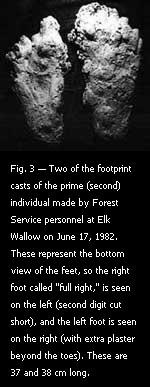 than the investigator's boots, in spite of the fact that they covered over twice the area of these boots. At the location of Freeman's alleged sighting, the Forest Service conducted a test at the urging of an individual visiting from Seattle. A piece of metal the size and shape of one of the footprints was cut, and this was placed on the dirt road near a track. An auto jack was then put on it, and this was used to raise the rear end of a pickup truck. They found that this metal plate was impressed into the ground less that the actual footprints. From this fact, and given the weight of the half supported truck, the Seattle individual concluded the "thing" weighed 4,000 pounds (1914 kg). None of the foresters agreed with this weight (widely quoted in the press), allowing only one-fourth of it at most.
than the investigator's boots, in spite of the fact that they covered over twice the area of these boots. At the location of Freeman's alleged sighting, the Forest Service conducted a test at the urging of an individual visiting from Seattle. A piece of metal the size and shape of one of the footprints was cut, and this was placed on the dirt road near a track. An auto jack was then put on it, and this was used to raise the rear end of a pickup truck. They found that this metal plate was impressed into the ground less that the actual footprints. From this fact, and given the weight of the half supported truck, the Seattle individual concluded the "thing" weighed 4,000 pounds (1914 kg). None of the foresters agreed with this weight (widely quoted in the press), allowing only one-fourth of it at most.
 than the investigator's boots, in spite of the fact that they covered over twice the area of these boots. At the location of Freeman's alleged sighting, the Forest Service conducted a test at the urging of an individual visiting from Seattle. A piece of metal the size and shape of one of the footprints was cut, and this was placed on the dirt road near a track. An auto jack was then put on it, and this was used to raise the rear end of a pickup truck. They found that this metal plate was impressed into the ground less that the actual footprints. From this fact, and given the weight of the half supported truck, the Seattle individual concluded the "thing" weighed 4,000 pounds (1914 kg). None of the foresters agreed with this weight (widely quoted in the press), allowing only one-fourth of it at most.
than the investigator's boots, in spite of the fact that they covered over twice the area of these boots. At the location of Freeman's alleged sighting, the Forest Service conducted a test at the urging of an individual visiting from Seattle. A piece of metal the size and shape of one of the footprints was cut, and this was placed on the dirt road near a track. An auto jack was then put on it, and this was used to raise the rear end of a pickup truck. They found that this metal plate was impressed into the ground less that the actual footprints. From this fact, and given the weight of the half supported truck, the Seattle individual concluded the "thing" weighed 4,000 pounds (1914 kg). None of the foresters agreed with this weight (widely quoted in the press), allowing only one-fourth of it at most.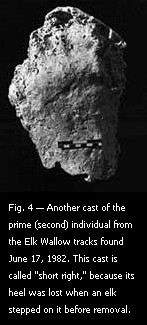 This excessive weight figure is easily dismissed because it is based on a gradual pressing of weight into the ground, in contrast to the impact of striding. A simple experiment illustrates this: One can walk with long and firm strides on fine moist soil, leaving clear footprints, then stop and walk slowly back to examine the tracks that were just made. One may then backoff and compare the "striding" tracks with the "walking" tracks, and see that the latter are far less impressed. I have found that, in most cases, even hard stamping in-place will not match the impressions just previously made in striding. Full striding impacts the body weight, at some speed, entirely on the heel area initially, and with a slight forward motion as well. In leaving the ground the body weight is last impressed on the toe area, with the force of stepping off, and also with a slight backward motion.
This excessive weight figure is easily dismissed because it is based on a gradual pressing of weight into the ground, in contrast to the impact of striding. A simple experiment illustrates this: One can walk with long and firm strides on fine moist soil, leaving clear footprints, then stop and walk slowly back to examine the tracks that were just made. One may then backoff and compare the "striding" tracks with the "walking" tracks, and see that the latter are far less impressed. I have found that, in most cases, even hard stamping in-place will not match the impressions just previously made in striding. Full striding impacts the body weight, at some speed, entirely on the heel area initially, and with a slight forward motion as well. In leaving the ground the body weight is last impressed on the toe area, with the force of stepping off, and also with a slight backward motion.Applying this knowledge to the tracks in question does not give an exact figure of weight, but it moves the reasonable estimate back to nearer Freeman's guess of 800 - 1,000 lbs, or about 400 kg. Of course, this all refers to the first individual from the sighting event of June 10. The second individual's tracks, found on June 17, were slightly larger and impressed to a similar degree. Thus, the tracks that are considered in detail here were quite possibly pressed into the ground with a weight of as much as 400 kg.
The two right footprints (Figs. 3 and 4) are especially instructive in respect to differences in the depths of toe impression. At the metatarsal ends, the "full right" footprint has a deeply impressed digit I, while the "short right" one (missing the heel) has a more deeply impressed digit II. The toes of "short right" are impressed into the substrate only sightly less than the metatarsal ends; but digits II-V of "full right" turn somewhat upward and some of their tips are not recorded. This is also evident in digit V of "full left," where the arched ridge pattern, first taken to be the tip of the toe actually appears to be from the metatarsal pad, and the tip does not show.
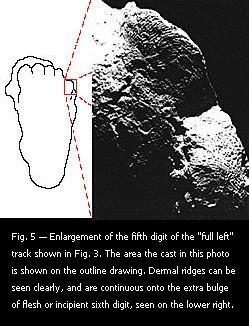 A peculiarity of the "full left" track (Fig. 5) is the extra pad of flesh to the lateral side of the base of digit V. Dermal ridges pass directly from digit V onto this pad, so it is not a double strike of the fifth digit. Since this pad does not appear on either of the "right" tracks, its exact nature is not clear. It may result from connective tissues in the sole pad that were under a normal tension. Possibly it is an incipient sixth digit.
A peculiarity of the "full left" track (Fig. 5) is the extra pad of flesh to the lateral side of the base of digit V. Dermal ridges pass directly from digit V onto this pad, so it is not a double strike of the fifth digit. Since this pad does not appear on either of the "right" tracks, its exact nature is not clear. It may result from connective tissues in the sole pad that were under a normal tension. Possibly it is an incipient sixth digit.The "short right" track shows what may be a double strike of digit where that toe was first pressed against digit III, then glanced off a small stone and into a more normal position. A cast of that stone is preserved in the track (Fig. 6). In order to make such a movement, the digit had to shift to the side after it first pressed into the ground, roll over the stone, and press in again. The first pressing of digit II against digit III is indicated by the set of V-shaped ridges meeting in a cleft (Fig. 7). This cleft might also be taken as a deep scar between the toes, but this would not explain the apparent two impressions of digit II.
Perhaps the most interesting of the gross characteristics of the prints is the large stone impression in the middle of "full right." This stone was photographed in the actual track before the cast was made (Fig. 8). It measures about 9 cm long, by 7 cm wide, and stands up into the footprint cast to a maximum of 2 cm toward the rear part. The footprint maker simply stepped on a large stone and pressed it down into the dirt around it on all sides. This was not a double action, hitting on one side then twisting over to press down on the other. Such a double imprinting would have left corresponding breaks in the imprint to the front and rear of the stone — but there are none.
The significance of this stepped-on stone is that it shows the sole of foot had a very thick padding
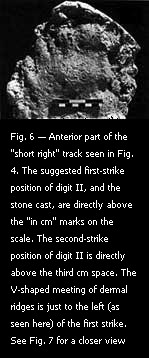 that was also very flexible. Mobility of bone connections cannot account for most of this indentation. The deepest part is close enough to the back of the foot that only the calcaneous, or heel bone, is involved. It is obvious that the sole pad must have had a thickness somewhat greater than the 2 cm depth of the stone's indentation. This applies to the osteologically more rigid rear part of the foot, and may be much the case in the forefoot, where there is more movability between the bones.
that was also very flexible. Mobility of bone connections cannot account for most of this indentation. The deepest part is close enough to the back of the foot that only the calcaneous, or heel bone, is involved. It is obvious that the sole pad must have had a thickness somewhat greater than the 2 cm depth of the stone's indentation. This applies to the osteologically more rigid rear part of the foot, and may be much the case in the forefoot, where there is more movability between the bones.A flexible sole pad is further supported by the configuration of the edges of the footprint indentations. These are nearly vertical in many areas, and actually overhang by as much as 1 cm in one place. This overhang (or undercut of the impression) might have been caused by sagging of the surrounding dirt after the imprints were made, although personal observation of many tracks makes this seem unlikely to me. A rigid structure could not have pressed laterally against the walls of its impression, then withdrawn medially in removal. A flexible foot, especially one with a thick sole pad, would make just these movements, leaving an impression that can be wider at the bottom than it is nearer the top. Detailed skin impressions are visible on some of these vertical and overhanging walls, with dermal ridges clearly showing in one case near the heel of "full right" (Fig. 9). These details are directly imprinted into the side walls, and thus could not have been made by a rigid structure with any combination of movements.
The presumption of a thick sole pad was also indicated by four footprint casts from Gray's Harbor County, Washington, made earlier in 1982 by the Gray's Harbor Sheriff's Department. These tracks show such identity of detail with each other that a single foot was almost surely involved. Yet they varied in breadth by as much as a centimeter from one print to another. Varying pressure on a thick flexible, sole pad was clearly suggested in that case, too.
The logical expectation of such a thick sole pad has long been indicated by the apparent ratio between body weight and foot surface area. With increasing body size, surfaces increase by the square of linear dimension while body volume (and weight) increases by the cube. Thus, the larger hominid puts more weight on a given area of sole than does a smaller one.
The reported unusually heavy-set Sasquatch bodies only add to the problem. A typical man, 170 cm tall, will have a foot 26 cm long. His 65 kg
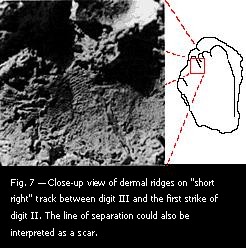 body weight will be distributed over about 200² cm of one foot (at times), or about 0.325 kg per cm². Our reconstructed Sasquatch, 2.4 - 2.5 m tall, has a foot 37.5 cm long. Its 400 kg body weight is distributed over 486² cm (actual measure) of one foot, or about 0.822 kg per cm².
body weight will be distributed over about 200² cm of one foot (at times), or about 0.325 kg per cm². Our reconstructed Sasquatch, 2.4 - 2.5 m tall, has a foot 37.5 cm long. Its 400 kg body weight is distributed over 486² cm (actual measure) of one foot, or about 0.822 kg per cm². The above figures assume the same ratio of stature to foot length in the human and the Sasquatch. Evidence on this point is mixed. If we follow the measurements estimated from the Patterson film of 1967 (Krantz 1972b), a 37.5 cm foot indicates a smaller Sasquatch with a body weight of only about 250 kg. This would put 0.514 kg on each cm² of the foot — still more than half again as much weight per unit area on the sole of the foot as in a normal human. This is probably the minimum possible figure.
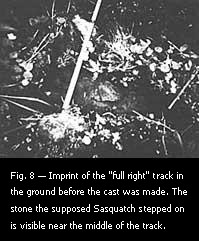 Such a thick sole pad would presumably be made largely of fat, but would have to be strongly interlaced with, and partitioned by, connective tissue running in many directions. This design would allow for the retention of a typical higher-primate friction-skin surface with a minimum of internal restructuring. This conclusion, which was based only on Sasquatch footprint morphology and estimated body sizes, is supported by data on the gorilla foot. Raven (1950: 217) describes the gorilla sole as follows: "The subcutaneous connective tissue ... is very thick and fatty and similarly has a framework of heavy collagenous septa." And (1950: 71): "The fatty pad of the sole is everywhere covered by dense connective tissue. The fat is thin along the middle of the foot but is very thick, 2.5 cm under the heel." Given that the Sasquatch may weigh twice as much as the gorilla, and is entirely bipedal, it is reasonable to expect the same sole structure, but to an exaggerated degree.
Such a thick sole pad would presumably be made largely of fat, but would have to be strongly interlaced with, and partitioned by, connective tissue running in many directions. This design would allow for the retention of a typical higher-primate friction-skin surface with a minimum of internal restructuring. This conclusion, which was based only on Sasquatch footprint morphology and estimated body sizes, is supported by data on the gorilla foot. Raven (1950: 217) describes the gorilla sole as follows: "The subcutaneous connective tissue ... is very thick and fatty and similarly has a framework of heavy collagenous septa." And (1950: 71): "The fatty pad of the sole is everywhere covered by dense connective tissue. The fat is thin along the middle of the foot but is very thick, 2.5 cm under the heel." Given that the Sasquatch may weigh twice as much as the gorilla, and is entirely bipedal, it is reasonable to expect the same sole structure, but to an exaggerated degree.Analysis of detailed anatomy
I have already alluded to the dermal ridges and sweat pores that characterize friction skin on the palms and soles of all higher primates, and not of other mammals. These ridges are clearly evident in the three casts in question. They cover most of the toe areas, and can be seen in scattered parts of the rest of the sole. (The following comments on the skin details are based on long discussions with various experts in the field, [see Addendum], and such sources as Cummins and Midlo [1943], and Olsen [1978].)
From ridge to ridge, these lines are spaced about 1/2 mm apart — more in some areas and less in others. This kind of spacing is typical for almost all higher primates, regardless of body size. Within a primate species, large individuals (usually males) have ridges somewhat farther apart than in small individuals. The number of ridges in the fetus is geared to the average adult body size of the species, so those individuals that grow to larger sizes have the given number of ridges more spread out, and vice-versa. Friction skin tends to have the optimum density of ridge spacing for best adhesion to smooth objects. The number of lines laid down in the fetus varies according to the adult size for each species. There is no adjustment for sexual size differences. Thus, it is not clear whether our 38 cm tracks were deposited by a male or female.
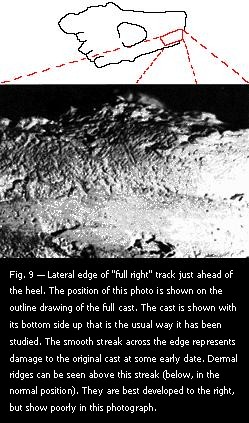 The near constancy of ridge spacing in primates rules out one method of faking. Latex molds of real skin, soaked in kerosene, will expand greatly; there may also be other methods of expanding molds. This procedure could produce gigantic skin patterns (in some respects), but the ridge spacing would also be expanded, and thus easily recognizable as abnormal.
The near constancy of ridge spacing in primates rules out one method of faking. Latex molds of real skin, soaked in kerosene, will expand greatly; there may also be other methods of expanding molds. This procedure could produce gigantic skin patterns (in some respects), but the ridge spacing would also be expanded, and thus easily recognizable as abnormal.The dermal ridges in these track casts show bifurcations, terminations, and isolated short segments in various places. These are the same kinds of variations that are seen in human dermatoglyphics, and they occur with normal frequencies.
If a dermal ridge running across a toe is counted as "one," and a ridge of similar length on the sole as another, then these three track casts display almost a thousand dermal ridges. Each of those that has been carefully observed is a smoothly rounded ridge in cross section, and not a scratch or V-shaped groove as would be produced by engraving. The furrows are also rounded valleys between the ridges, and are relatively narrow. The spacing between ridges varies only gradually from one location to another; there are no abrupt breaks in pattern density.
Ridges can be seen in some places well off the sole, more than 2 cm up the side of the foot. This shows most clearly around the outside edge of the heel on the cast of "full right" (Fig. 9). The greater extension of friction skin up the edge of the foot, as compared with a much lesser degree on the hand, is normal in primate dermatoglyphics.
The ridges are clearest, and with the deepest relief, on those areas that bear the least weight. Around the edges of the foot itself, and around individual toes in particular, the skin should normally strike the substrate only briefly. In these areas, ridge to furrow depths are at a maximum. On the more weight-bearing surfaces of the sole and middle of the toe pads, the ridges appear to be somewhat worn down (Fig. 10). This is normal for a primate that walks a great deal on hard surfaces. I am told by a primatologist (preferring anonymity) that only a big gorilla, living in a concrete-floored cage, would wear down the ridges completely. Interestingly, the footprints at the Freeman sighting location (the first individual) show no ridges, except for a few traces around the edges in some places. Perhaps this individual had done considerably more walking than the second individual being studied here.
In the early fetal development of dermal ridges (and presumed evolution), each sweat pore has a tiny cone, or pebble, of skin surrounding it. As
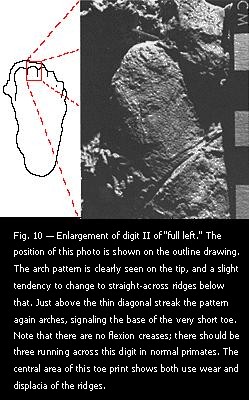 growth progresses, these cones line up in fixed patterns and merge together into unbroken ridges. Sometimes, this development partially fails, and many of the ridges consist only of a jumble of very short segments. This condition is known as displacia (or dysplasia), and tends to affect mostly those central areas of greatest weight support where the ridges are also most worn down. While the two conditions topographically coincide, they should not be confused, because they have separate origins and morphology. In affected areas, the directions of dermal ridge sets can still be made out by observing the general trend of orientation of the short segments.
growth progresses, these cones line up in fixed patterns and merge together into unbroken ridges. Sometimes, this development partially fails, and many of the ridges consist only of a jumble of very short segments. This condition is known as displacia (or dysplasia), and tends to affect mostly those central areas of greatest weight support where the ridges are also most worn down. While the two conditions topographically coincide, they should not be confused, because they have separate origins and morphology. In affected areas, the directions of dermal ridge sets can still be made out by observing the general trend of orientation of the short segments.Our second individual shows this form of displacia as it occasionally occurs in humans. The pattern in some toe tips and over the fore-part of the sole (in "full right") is somewhat confused and hard to follow. Nevertheless, the trend on this one recorded instance of a midsole print is transversely across the sole. This is the hominid pattern, as opposed to the pongids, where the trend in this area is diagonally from anterior-medial to posterior-lateral (Biegert 1961). This contrast should be used with caution because apes show high variability, and some of them approach the human orientation in parts of the sole. The first (Freeman-sighting) individual's sole was too worn to determine if it showed displacia.
In at least one place the ridge-trend abruptly changes direction, with no apparent reason. While this has puzzled three examiners, it is actually a perfectly normal phenomenon, though rare. This is another form of displacia, or dissociation, of dermal ridges, and is discussed by Olsen (1978). Even more extreme examples have been reported in palm prints. In one human case, a 1 cm circular patch, sharply outlined, has its ridges turned 90° from those of the surrounding skin (Olsen, personal communication).
The ridge alignment is slightly broken up on some toe tips, but the basic print pattern can still be determined. The toe tip patterns are mostly arches (Figs. 5 and 10), while digit I of "full left" appears to have a loop (Fig. 11 ). On the fingertips, arches occur rarely in humans — showing in just over 10% of individuals only among Congo Pygmies and South African Bushmen. On the toes, they occur somewhat more frequently, but are still in the minority.
On the shafts of the toes, the ridge pattern begins to follow the primate norm of running straight across. At the bases of the toes, which are surprisingly short, new patterns again can be seen on the metatarsal pads. None of these can be followed through clearly in their entirety, but an "arching" design is the most common in the distal areas of these pads. The best cast, "full left," seems to show the beginnings of a loop pattern at the base of digit II (Fig: 10), and perhaps on digit I (Fig. 11), while digit V (Fig. 5) simply arches as far as the lines can be traced. These are normal patterns for apes or humans.
In addition to being unusually short for such a foot size, the toes show another peculiarity that does not occur in primate feet. They have no
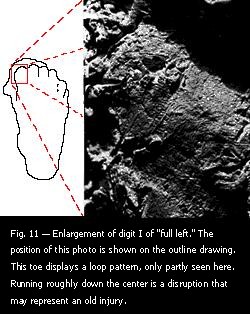 flexion creases (see especially Fig. 10). Ideally, there should be three such creases, each corresponding to one of the three phalangeal joints, but in this case none are visible. I do not know how to interpret this absence, except to make note of it. It may not be a normal Sasquatch trait, because the toes on this particular individual are relatively even shorter than on other presumed Sasquatch footprints. The main significance, for now, may relate to the possibility of these tracks being faked with lifts and casts from real primate skin. How does one locate a group of people with arched thumbs of various sizes, and uniformly short, with none of them showing any flexion creases? While there are many pattern breaks with large blank areas on the soles, some of the toe prints are continuous from tips to metatarsal pads. No patching is indicated. I could find only one case in the literature of a human finger without flexion creases. Haylock (1983) illustrates one of a brachydactylous individual, where a very short digit II lacks creases and has a continuous arch pattern from the tip to the metacarpal end.
flexion creases (see especially Fig. 10). Ideally, there should be three such creases, each corresponding to one of the three phalangeal joints, but in this case none are visible. I do not know how to interpret this absence, except to make note of it. It may not be a normal Sasquatch trait, because the toes on this particular individual are relatively even shorter than on other presumed Sasquatch footprints. The main significance, for now, may relate to the possibility of these tracks being faked with lifts and casts from real primate skin. How does one locate a group of people with arched thumbs of various sizes, and uniformly short, with none of them showing any flexion creases? While there are many pattern breaks with large blank areas on the soles, some of the toe prints are continuous from tips to metatarsal pads. No patching is indicated. I could find only one case in the literature of a human finger without flexion creases. Haylock (1983) illustrates one of a brachydactylous individual, where a very short digit II lacks creases and has a continuous arch pattern from the tip to the metacarpal end.Dermal ridges were first suspected on the cast of a hand print, ascribed to a Sasquatch, that was recovered in Northeastern Washington in 1970 (Krantz 1971). In this case, parallel ridges are evident on the edge of one finger, near the tip. They are spaced 1 mm apart, thus making their identification as dermal ridges somewhat uncertain. Other footprint casts have been sought out and examined since the Walla Walla discovery, but nothing more than suggestive traces could be found in a few cases. This is not surprising because of the fortunate, and rare, circumstances in this instance.
In many places in the specimens considered here one can see small indentations, or pores, located along the ridges. These are typically spaced about 0.5 mm apart, and are centered on the ridges. They vary in size from barely visible, less than 0.1 mm, up to a diameter of 0.2 mm. The ridges visibly widen around each of these pores. This is most clearly seen at the base of digit I of the "full left" track (Fig. 10). The margins of these pores curve gradually inward to the centers — there is not a sharp edge. Several forensic specialists who have examined this material agree that these are sweat pores.
The sweat pores are generally lined up regularly on adjacent dermal ridges, as opposed to having alternating or random positions. In other words, the pores also occur along lines drawn perpendicular to the ridges. This pattern is not regular, but it is a strong tendency — just as in human dermatoglyphics (see Figs. 10, 11, and 12).
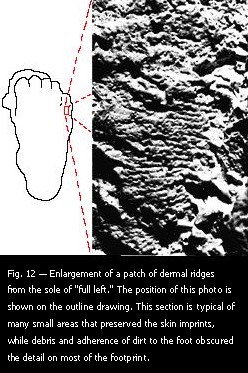 The possibility that air bubbles might have mimicked sweat pores was suggested by physical anthropologist Tim White, at the University of California, Berkeley, who otherwise thought the casts appeared to represent legitimate footprints. To settle this point, I made impressions of false ridges (with a fine comb) in similar soil, and cast them in plaster. I compared the results with the actual casts, and found that there are, in fact, occasional air bubbles from casting. These bubbles, however, are sharp-edged, and are not as small as the apparent sweat pores. They are rather few, and not regularly spaced or lined up. In some cases, they also bulge out the ridges around them, but only slightly, and with a much thinner wall between the hole and the ridge edge than with the presumed pores (Fig. 13).
The possibility that air bubbles might have mimicked sweat pores was suggested by physical anthropologist Tim White, at the University of California, Berkeley, who otherwise thought the casts appeared to represent legitimate footprints. To settle this point, I made impressions of false ridges (with a fine comb) in similar soil, and cast them in plaster. I compared the results with the actual casts, and found that there are, in fact, occasional air bubbles from casting. These bubbles, however, are sharp-edged, and are not as small as the apparent sweat pores. They are rather few, and not regularly spaced or lined up. In some cases, they also bulge out the ridges around them, but only slightly, and with a much thinner wall between the hole and the ridge edge than with the presumed pores (Fig. 13).One fingerprint expert (with the Vancouver, B.C. Police Department) pointed out that sweat pores often have irregular edges, while these pores sometimes appear quite circular. This discrepancy results from the method of observation. Inked fingerprints used by law enforcement agencies record the very outermost edges of the pores, and these are usually not quite circular. Photographs of many of these cast pores show only shadows, thrown deeper into the holes, where active sweat pores are in fact perfectly rounded. Others, with more oblique illumination, show the typical irregularities of outline.
Discussion and implications
Thus far, every specialist who has examined these casts agrees that their detailed anatomy has all the characteristics and appearance of being derived from an imprint of primate skin. These now include thirty police fingerprint workers, mostly from the Western states, twelve of whom might be considered experts. Also included are six physical anthropologists with expertise in this area, as well as four pathologists and two zoologists. At present, two of the police experts are willing to state categorically that the prints actually represent the existence of a real but unknown animal, regardless of the implications (see Addendum). Interestingly, these two are not only among the most highly qualified; they are also the two who have studied the material more thoroughly.Even the strongest critic, a mammalogist at the Smithsonian Institution, agrees that the casts represent primate skin, but he thinks that it must have been transferred from known animals by silicone rubber casting and combined somehow to form the tracks. His examination of the casts was brief. Another strong critic, a leading medical authority on skin in the Pacific Northwest, also agreed that the impressions were undoubtedly of primate friction skin, but left open the question of how they came to be located on these tracks. His examination of the casts was somewhat longer. Neither of these experts attempted to specify the source of the skin that might have been transferred to these tracks.
In their gross anatomy, the tracks could not have been made by any known animal. They are too large to be human, and the length of stride and
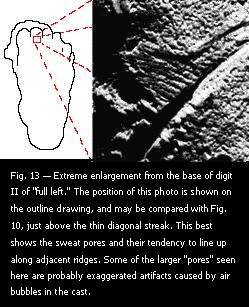 depth of imprinting are also beyond human capability. Human feet do not have the flexibility of sole to conform to the large stone that was stepped on in one case. The toe design is also beyond the range of human feet in that they are relatively too short, toes II through V are too wide, and they line up too nearly straight across the front of the foot.
depth of imprinting are also beyond human capability. Human feet do not have the flexibility of sole to conform to the large stone that was stepped on in one case. The toe design is also beyond the range of human feet in that they are relatively too short, toes II through V are too wide, and they line up too nearly straight across the front of the foot.For all of the above reasons, no ape foot comes anywhere near matching these casts. In addition, all apes show some degree of opposability of the first digit, which is not seen in these casts. The lack of a longitudinal arch in these feet, interestingly, is not an argument against either human or ape identification.
Bear feet can easily be eliminated on gross anatomy. Again, these tracks are too large for the hind foot of any bear, in which the first toe is the shortest and the third is the longest. Bear tracks also generally show claw marks, and have especially narrow heels. No other animal feet need seriously be considered.
There are only two possible explanations to account for these footprints, short of denying their existence. Either they were fabricated somehow by a modern human hoaxer, or else they are the tracks of a presently unrecognized animal.
Previous studies have already dealt with most of the problems faced by a potential hoaxer of tracks like these in terms of physical circumstances. They need only be listed here for this case as reminders. The hoaxer had to penetrate a watershed area that is closed to the public by the U.S. Forest Service. This had to be done without leaving any noticed evidence of vehicles or human footprints into or out of the area. The unlikelihood of the tracks being discovered at least suggests that dozens or hundreds of sets of tracks must have been made in order to insure the discovery of some of them. The long stride, commonly 1.2 m, is difficult to manage even without big fake feet. Stepping once on the heel while coming down a 2 m embankment should have toppled any hoaxer on his face at the bottom. The depth of imprint means that, even if the hoaxer weighed 150 kg; he was carrying an additional weight of maybe 200 kg — and still managing long strides. He also managed to walk for at least three-quarters of a mile with all this equipment — that is how far the search and rescue team from Oregon was able to backtrack the first individual.
Accounting for the gross morphology of the tracks presents an equally baffling set of obstacles. The hypothetical hoaxer somehow knew how to make the soles flat, the toes short and wide with only a modest emphasis on digit I, the forefoot almost squared off, and the heel abnormally wide. These would not have been too difficult to execute if some of my published descriptions of tracks were consulted. But he also knew enough to introduce two other variations that I noted back in 1970; these have never been written down nor told to anyone.
Some innovations added here include the apparent double strike of one toe that must have been difficult to manage. One cannot help wondering why the extra pad of flesh was included next to digit V of the "full left" track, which looks almost like an incipient sixth digit. The deep indentation in midsole of the "full right" track shows a surprising degree of flexibility of the foot and thick cushioning. How the hoaxer managed to walk on top of these flexible pads is another problem — unless he was long accustomed to doing this.
Earlier descriptions of authentic-seeming Sasquatch tracks often included the "double ball." This is seen clearly in the partial left track, but for various reasons it did not show in the other two tracks. Differences in the relative depths of imprinting of the metatarsal ends between the tracks requires some explanation — perhaps separately articulated pseudo-bones in faked feet. Also, different inclinations of the toes between the two right feet implies still more structural complexity in the "feet."
The hoaxing problems recounted up to now strain the imagination. Yet, similar circumstances have been reported by reliable observers many times in the past, for which no good explanation has been forthcoming. The usual approach of the debunkers is simply to ignore the situation, or to insist that the facts have not been correctly reported. When the actual tracks have eroded away, and memories have faded, all that remain are some big plaster casts. Little argument is left.
In this case, however, the three plaster casts show a degree of detailed anatomy that cannot be dismissed so easily. The supposed track hoaxer somehow managed to include microscopic detail that matches the foot skin of a higher primate. There are clearly formed dermal ridges, with sweat pores, over large parts of these three imprints. These details are of the correct size, shape, and orientation in each area for gigantic hominid feet. Some peculiarities include arched toe-tip prints, and very short toes that lack flexion creases. All possible sources of primate friction skin have been considered, and none can account for these characteristics. In addition, the hoaxer had the ridge relief slightly worn down in exactly the areas where the most weight would be supported on feet of this size and design. Finally, the incomplete pattern formation of displacia occurs on just the areas where it would be normal for feet and toes of this size.
Our track maker is an excellent outdoorsman of incredible size and strength. He is able to move about, largely unseen, over vast wilderness areas, leaving many tracks. He does not depend on vehicles to get in and out of the areas where the tracks are found. He is able to imprint the ground with tracks that are anatomically correct for a gigantic hominid. And he is able to leave, on occasion, clear impressions of primate friction skin. Such a track maker is not really impossible — just not Homo sapiens.
After removing any possibility of a human hoaxer, we can consider the footprints on face value. Using only the three prime footprints described above, the track maker can be reconstructed as follows. The skin makes it ` a higher primate, without specifying monkey, ape, or man. It is bipedal (no hand or knuckle prints show), and thus with upright posture. The stride indicates a stature of almost 2.5 m if it has a human body-to-leg ratio, where stature is twice the striding gait. (If it has an ape or monkey ratio it must be somewhat taller.) A body weight of about 400 kg is consistent with the depth of impressions, and with the indicated sole cushioning pad. The stature and weight would indicate a body build much more heavy-set than is usual for humans. The short toes, nondiverging first digit, and transverse midsole ridges all indicate a hominid — a member of the zoological family Hominidae that also includes humans. Granting the hominid status, it would have broad shoulders like any other ex-brachiator. One could also presume from the track locations, and the lack of any communications between them and ourselves, that they are not "human" in any cognitive and social meanings of the word.
The above description is consistent with Paul Freeman's sighting report of the animal that started this particular investigation. Many hundreds of other people have described seeing essentially the same kind of biped. All such reports also include reference to a full covering of body hair, usually dark brown in color. This might be a reasonable expectation for a nonhuman higher primate, especially in a temperate climate. Most observers say the arms are relatively longer than is usual for humans — they are also more massive, especially at the shoulders. It is often noted that the head is set low, with no constriction showing at the neck. The face is described as being nearly flat, with little muzzle projection, and with deep-set eyes under projecting brow ridges. It has a head that rises only gradually behind the brows to a low peak toward the rear.
These last named traits are entirely consistent with the animal described from the footprints. It does not automatically follow that our track maker has all these additional traits, but it would be a most peculiar situation if it did not. That possibility would presuppose the existence of a giant hominid that leaves footprints and has never been seen, and another species of giant, hairy, gorilla-faced hominid that is often reported, but which leaves no footprints! The simplest resolution to this is that the footprints and descriptions may be ascribed to the same animal.
It may seem as if a large edifice has been erected on the base of just three footprints that were cast in plaster by the U.S. Forest Service in 1982. Actually, the edifice has been there all along, based on many hundreds, perhaps thousands, of footprint events and observations accumulating for over a century. The fact that direct, substantial proof of the animal has not been produced, combined with the fact that a proportion of the evidence has been demonstrated to be false, has led most biological scientists to deny the existence of the species. One prominent physical anthropologist has told me that, if these tracks were the first and only evidence available, the animal would likely be accepted. But as it is, with so much publicity and fakery known and suspected in the past, such acceptance will not occur. It has been far easier for most scientists to assume that all the evidence is false, than it is to believe that a giant hominid has eluded verification for this long a time.
The evidence of these three track casts has been presented (directly or by photographs) to many experts in the appropriate fields. The reactions of two major groups are significantly different. In the fields of physical anthropology and zoology, most of the responses have ranged from mild interest to flat denial that they could be real. Among fingerprint experts and pathologists, the responses have ranged from mild interest to enthusiastic acceptance.
To most anthropologists and zoologists, the implications of these tracks, if authentic, are profound. It would mean that their sciences have completely missed one of the biggest and potentially most important mammalian species on earth. They may even fear that the public might ask, if they were so wrong in this case, what else might they be overlooking? I have heard of instances in which scientists have sincerely expressed the hope that Sasquatch will never be proven, exactly because of these implications. It has also been suggested that anthropologists are still smarting from the expose of the Piltdown hoax, and that their public image would be severely damaged by another such instance. To them, I need only point out how almost all geologists firmly opposed the idea of continental drift until the late 1960s — they survived.
Police fingerprinters and pathologists generally have no stake in whether or not such a creature exists. It is outside their normal area of concern, and few have made any past pronouncements on the subject. They risk no professional embarrassment by its demonstration. If anything, they might be more concerned about the possibility that a hoaxer has developed a technique that can be used to fake fingerprints.
The evidence of this new set of tracks should be treated as conclusive by all authorities, but it is not. If and when a Sasquatch skeleton or fresh specimen is recovered, it would require little intelligence to conclude that the species has existed all along. What does require some reasoning power is to move from the presently available data to a clear conclusion as to either the method of hoaxing or to the reality of the animal.
Addendum (Opinions by Other Experts)
Tatyana Gladkova, Dermatoglyphics expert at the USSR Institute of Anthropology. Saw photographs of casts, including enlargements of key areas. (Response provided through Dmitri Bayanov, Moscow, USSR.)I see dermal ridges of the arch type distally directed. I see sweat pores. If it's a fake, it's a brilliant fake, on the level of counterfitting, and by someone well versed in dermatoglyphics.Anthropologists Mikhail Urisson and Vladimir Volkov-Dubrovin (Deputy Director of the Institute) agreed with the above opinion.
Henrietta Heet, Candidate of Biological Sciences and Senior Scientific Worker, Institute of Ethnography of the USSR Academy of Sciences. Saw several photographs and brief description of circumstances of discovery. (Response provided through Dmitri Bayanov, Moscow, USSR.)
Regarding photographs of skin imprints sent over by G. Krantz. I fully agree with his opinion on these footprints, as well as the opinion of Benny Kling. The structure of the dermal ridges is very much like that of man. The sweat glands have large openings because the ridges are much bigger than in man. It was great luck that the footprints were left in the soil that revealed fine details of the imprints. As for the patterns of ridges, some irregularity in ridge lines in separate places in the photos may be connected with the peculiarity of the material in which the imprints were made (unevenness of soil, various inclusions, such as small pebbles, pine needles, etc.). Another possibility is scars and skin injuries.Douglas M. Monsoor, Supervisor, Criminalistics Unit, Department of Public Safety, Lakewood, Colorado. Certified Latent Print Examiner, and fellow of the Fingerprint Society of the United Kingdom. Was sent detailed photographs in late 1982, examined original casts in December, 1982, and again in June, 1983, for two hours on each occasion.
Incidentally, even in ideally made human imprints there can be such irregularities. There is even a whole branch of dermatoglyphics studying genetic irregularities in ridge lines, i.e. medical and genetic dermatoglyphics.
In the imprints shown by the available photographs, I cannot detect anything unusual, except digit I, left foot, which shows, apparently, a pattern of the arch type (in man the whorl type is more frequently found).
I see the presence of ridge structure in these track casts which, in my examination, appears consistent with that type of ridge structure you would find in a human. Under magnification, they evidence all the minute characteristics similar to human dermal ridges. The sizes, distributions, and orientations of the ridge patterns are consistent with those found on a human foot. Of the ridge structure visible in the impressions, I believe it was produced concurrent with the creation of the overall impressions, and not added later.Robert D. Olsen, Sr., Criminalist, Kansas Bureau of Investigation, Topeka, Kansas. Certified Latent Print Examiner, Fellow of the American Academy of Forensic Sciences, Fellow of the Fingerprint Society of the United Kingdom, Member of International Association for Identification, etc. Was sent detailed photographs in late 1982, and Silastic lifts in early 1983. Examined original casts and two-color lifts in June, 1983, for several hours.
If hoaxing were involved, I can conceive of no way in which it could have been done. They appear to be casts of original impressions of a primate foot — of a creature different from any of which I am aware.
Based on everything I see, there is nothing in these tracks that is inconsistent with the impressions of an actual living primate foot. Ridges and pores are consistent with real primate skin. I'm convinced that this represents real friction skin and shows no inconsistencies in structure or orientation.Edward Palma, Fingerprint examiner for the Laramie County Sheriff's Department, Cheyenne, Wyoming. Had latex lifts from the footprints in late 1982 — inked these and traced print pattern extensively. Had cast copies to examine at leisure. Saw original casts for several hours in early 1983 — made Duplicast impressions of critical parts, and took photographs for further study.
If they are faked, the individual would have to know an extraordinary amount about fingerprinting. I could not have done it. A faker would have to be an accomplished artist as well as an expert on dermatoglyphics. He would also need a knowledge of gross anatomy of feet. The amount of time needed to do all this work is beyond the realm of believability.
My professional opinion of the three casts is that they represent footprints of a living higher primate of an unknown species. The over-all configuration of the foot is roughly human, but it is too wide — a human foot would not be over five and one half inches [wide] for this length, and thus these impressions could not be human. The actual width is represented and supported by ridge pattern.Benny Kling, Instructor, Law Enforcement Academy, Douglas, Wyoming. Had latex lifts from the footprints in late 1982, and cast copies shortly thereafter. Saw original casts for several hours on two occasions in early 1983.
My study of the tracks concentrated more on the sole than on the more conspicuous details of the toes. I traced the ridge pattern over the entire breadth of the forefoot, finding triradius landmarks appropriate in their respective positions with intervening ridges flowing in proper directions. It could not have been patched together from smaller parts that were copied from skin of a known primate.
The detailed morphology of the ridge and furrow structures and patterns are especially convincing to me. In all details, they conform perfectly in design and size to real friction skin. The sweat pores are clear and are lined-up and spaced just as expectable, and can be distinguished from occasional air bubbles in the casts.
I began this investigation with the goal of showing how these prints were, or might have been, faked. All evidence now tells me that any faking would be impossible.
These track casts show all the characteristics of real friction skin derived from a higher primate footprint. The ridge details, in all respects, duplicate that found in human feet. Parts of the pattern on right and left feet are near-mirror images; some displacia is indicated in the areas where it could be expected; smoothing by wear shows on the weight-bearing areas. In addition, the footprints indicate that an unusual proportion on the body weight fell on the front of the foot, and the arches are evidently flat.
This kind of print could not have been made by a human foot, nor that of any known animal. It could not have been manufactured by any hoaxer; the design is too dermatoglyphically correct, and the engraving job would be beyond the capabilities of the best forger. Descriptions of the supposed Bigfoot, or Sasquatch, are consistent with the traits found in these footprints.
References cited
- Biegert, Josef. 1961, Volarhaut der Hande und Fusse. Primatologia, Vol. 2, Part 1(3): 1-326.
- Cook, Claude W. 1981, Footprints and Tire Tracks. Identification News, 31(7): 7-10.
- Cummins, Harold, and Charles Midlo. 1943, Fingerprints, Palms and Soles: an Introduction to Dermatoglyphics. Philadelphia: Blakiston.
- Green, John. 1978, Sasquatch: The Apes Among Us. Seattle: Hancock House.
- Haylock, S. E. 1983, Abnormalities in Dermatoglyphics. Identification News, 33(1): 11-14.
- Hunter, Don, and René Dahinden. 1973, Sasquatch. Toronto: McClelland and Stewart.
- ISC Newsletter, The. 1982a, Sasquatch in Washington State: New Reports Involve Footprints. Vol. 1(2):7-9.
- ISC Newsletter, The. 1982b, Walla Walla Casts Show Dermal Ridges. Vol. 1(3): 1-4.
- Krantz, Grover S. 1971, Sasquatch Handprints. Northwest Anthropological Research Notes, Vol. 5: 145-51.
- Krantz, Grover S. 1972a, Anatomy of the Sasquatch Foot. Northwest Anthropological Research Notes, Vol. 6: 91-104.
- Krantz, Grover S. 1972b, Additional Notes on Sasquatch Foot Anatomy. Northwest Anthropological Research Notes, Vol. 6: 230-41.
- Olsen, Robert D., Sr. 1978, Scott's Fingerprint Mechanics. Springfield, Illinois: Charles C Thomas.
- Raven, Henry C. 1950, The Anatomy of the Gorilla. New York: Columbia University Press.
From: Cryptozoology, 2, 1983, 53-81

No comments:
Post a Comment
This blog does NOT allow anonymous comments. All comments are moderated to filter out abusive and vulgar language and any posts indulging in abusive and insulting language shall be deleted without any further discussion.